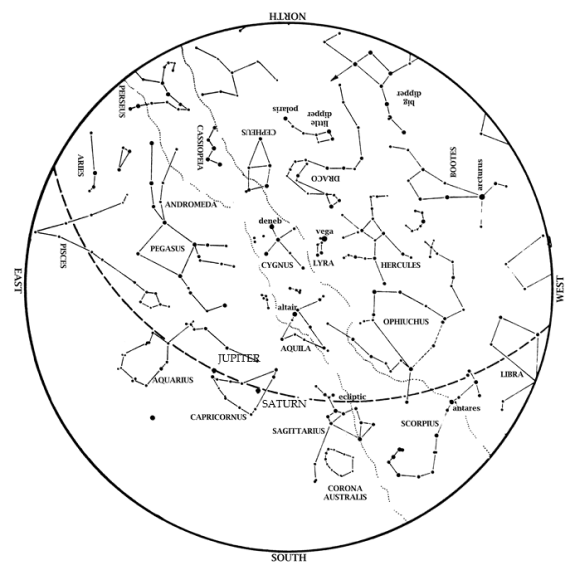
Venus remains in the evening sky this month. Venus outshines everything except the Sun and the Moon, so it is unmistakable low in the west southwest at dusk.
Jupiter and Saturn were up all night long last month, leaving them well placed for evening observing this fall. Look for Jupiter and Saturn rising in the east southeast as night falls and setting in the west southwest as day begins to break. Jupiter is brighter than all the stars we ever see at night. Saturn, to Jupiter’s right, is somewhat dimmer but still outshines all of the stars near it
Mars remains lost in the Sun’s glare this month and is thus not visible.
The Summer Triangle is high overhead at dusk. This consists of Deneb, Vega, and Altair, the brightest stars in Cygnus, Lyra, and Aquila respectively. Scorpius, the Scorpion, is in the southwest, with the ‘teapot’ of Sagittarius to his left. When you face between these two constellations, you face the direction of the galactic center, which all stars in the Milky Way orbit. From the Big Dipper’s handle, ‘arc to Arcturus’ in the west. The Great Square of Pegasus rises in the east, heralding the coming autumn.
If you are far enough from bright city lights, you might look for the Milky Way band. This band is brightest near the galactic center and extends from there right through the Summer Triangle. In fact, every star we ever see in the sky with the naked eye is in our Milky Way. Indeed, our galaxy is so big that only stars relatively close to us appear as distinct stars; the rest of our galaxy blurs out and appears as the Milky Way band across our sky. For example, Deneb is about 1600 light years away, which is quite far. The entire Milky Way, however, is 100,000 light years across, making Deneb one of our relative ‘neighbors’. Thus, we see our Milky Way as a blur in the background with stars like Deneb (and Vega, Altair, Arcturus, etc.) in the foreground.

This star map shows the Houston sky at 10 pm CDT on September 1, 9 pm CDT on September 15, and 8 pm CDT on September 30. To use the map, put the direction you are facing at the bottom.
The Summer Triangle is overhead. This consists of the brightest stars in Cygnus, Lyra, and Aquila. Scorpius, the Scorpion, is in the southwest, with the ‘teapot’ of Sagittarius to his left. Jupiter and Saturn are in the south in Capricornus. From the Big Dipper’s handle, ‘arc to Arcturus’ in the west. The Great Square of Pegasus is high in the east, heralding autumn.
Moon Phases in September 2021:
New September 6, 7:52 p.m.
1st Quarter September 13, 3:39 p.m.
Full September 20, 6:55 p.m.
Last Quarter September 28, 8:57 p.m.
At 2:21 pm on Wednesday, September 22, 2021, the Sun is directly overhead as seen from the equator, shifting southwards. This is therefore the autumnal (fall) equinox for us in the Northern Hemisphere. You have probably already noticed the Sun setting earlier and earlier each night since August. After the equinox, night becomes longer than day for us. Below the equator, on the other hand, days have been lengthening, and day becomes longer than night as of this equinox. For folks down there, this is the vernal (spring) equinox.
Many consider this the ‘official’ start of fall, although the actual arrival of fall weather varies from year to year. Keep in mind that air and water take some time to cool off, so even with the Sun lower in the sky, warm or even hot weather is common for us in September. This is why the fall equinox is much warmer than the spring equinox in March, when the Sun is at a similar height in the sky.
The Full Moon of September 20 is the closest Full Moon to the fall equinox. Therefore, it is the Harvest Moon. Ordinarily the Moon rises about 50 minutes later each night. However, the solar system plane (the ecliptic) makes a very shallow angle with our horizon at sunset near the fall equinox. Thus on the days near Full Moon this time of year, moonrise is only about 30 minutes later each night. This makes the Moon rise by the end of twilight for a few days after full. Long ago, harvesters could use that extra moonlight to work late into the night to bring in the harvest.
Our George Observatory is now open every Saturday night for observing! Purchase tickets in advance on our website.
Clear Skies!
Miss out on last month’s sky happenings? Check them out here.





